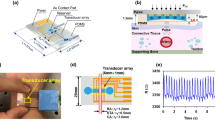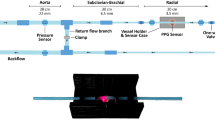Abstract
Arterial wall parameters (i.e., radius and viscoelasticity) are prognostic markers for cardiovascular diseases (CVD), but their current monitoring systems are too complex for home use. Our objective was to investigate whether model-based analysis of arterial pulse signals allows tracking changes in arterial wall parameters using a microfluidic-based tactile sensor. The sensor was used to measure an arterial pulse signal. A data-processing algorithm was utilized to process the measured pulse signal to obtain the radius waveform and its first-order and second-order derivatives, and extract their key features. A dynamic system model of the arterial wall and a hemodynamic model of the blood flow were developed to interpret the extracted key features for estimating arterial wall parameters, with no need of calibration. Changes in arterial wall parameters were introduced to healthy subjects (\(n=5\)) by moderate exercise. The estimated values were compared between pre-exercise and post-exercise for significant difference (\(p<0.05\)). The estimated changes in the radius, elasticity and viscosity were consistent with the findings in the literature (between pre-exercise and 1 min post-exercise: − 11% ± 4%, 55% ± 38% and 28% ± 11% at the radial artery; − 7% ± 3%, 36% ± 28% and 16% ± 8% at the carotid artery). The model-based analysis allows tracking changes in arterial wall parameters using a microfluidic-based tactile sensor. This study shows the potential of developing a solution to at-home monitoring of the cardiovascular system for early detection, timely intervention and treatment assessment of CVD.






Similar content being viewed by others
References
Bergel DH (1961) The dynamic elastic properties of the arterial wall. J Physiol 156:458–469
Buus NH, Carlsen RK, Khatir DS, Eiskjr H, Mulvany MJ, Skov K (2018) Arterial stiffness and peripheral vascular resistance in offspring of hypertensive parents: influence of sex and other confounders. J Hypertens 36:815–823
Doonan RJ, Mutter A, Egiziano G, Gomez Y-H, Daskalopoulou SS (2013) Differences in arterial stiffness at rest and after acute exercise between young men and women. Hypertens Res 36:226
Grabovskis A, Marcinkevics Z, Rubins U, Kviesis-Kipge E (2013) Effect of probe contact pressure on the photoplethysmographic assessment of conduit artery stiffness. J Biomed Opt 18:027004
Greenfield JR JC, Griggs JR DM (1963) Relation between pressure and diameter in main pulmonary artery of man. J Appl Physiol 18:557–559
Hurst JW, Logue RB, Schlant RC, Wenger NK (eds) (1978) The heart: arteries and veins, vol 986. McGraw-Hill, New York
Kelly R, Hayward C, Avolio A, O’rourke M (1989) Noninvasive determination of age-related changes in the human arterial pulse. Circulation 80:1652–1659
Lee JC et al (2017) Investigation of viscoelasticity in the relationship between carotid artery blood pressure and distal pulse volume waveforms. IEEE J Biomed Health Inform 22:460–469
Leguy C, Bosboom E, Gelderblom H, Hoeks A, Van De Vosse F (2010) Estimation of distributed arterial mechanical properties using a wave propagation model in a reverse way. Med Eng Phys 32:957–967
Lénárd Z, Fülöp D, Visontai Z, Jokkel G, Reneman R, Kollai M (2000) Static versus dynamic distensibility of the carotid artery in humans. J Vasc Res 37:103–111
Lichtenstein O, Safar ME, Mathieu E, Poitevin P, Levy BI (1998) Static and dynamic mechanical properties of the carotid artery from normotensive and hypertensive rats. Hypertension 32:346–350. https://doi.org/10.1161/01.hyp.32.2.346
Liu J, Cheng H-M, Chen C-H, Sung S-H, Hahn J-O, Mukkamala R (2017) Patient-specific oscillometric blood pressure measurement: validation for accuracy and repeatability. IEEE J Transl Eng Health Med 5:1–10
McEniery CM, Cockcroft JR, Roman MJ, Franklin SS, Wilkinson IB (2014) Central blood pressure: current evidence and clinical importance. Eur Heart J 35:1719–1725
Melo X, Fernhall B, Santos DA, Pinto R, Pimenta NM, Sardinha LB, Santa-Clara H (2015) The acute effect of maximal exercise on central and peripheral arterial stiffness indices and hemodynamics in children and adults. Appl Physiol Nutr Metab 41:266–276
Mutter AF, Cooke AB, Saleh O, Gomez Y-H, Daskalopoulou SS (2017) A systematic review on the effect of acute aerobic exercise on arterial stiffness reveals a differential response in the upper and lower arterial segments. Hypertens Res 40:146
Nejad SE, Carey JP, McMurtry MS, Hahn J-O (2017) Model-based cardiovascular disease diagnosis: a preliminary in-silico study. Biomech Model Mechanobiol 16:549–560
O’Rourke MF, Mancia G (1999) Arterial stiffness. J Hypertens 17:1–4
Pannier BM, Avolio AP, Hoeks A, Mancia G, Takazawa K (2002) Methods and devices for measuring arterial compliance in humans. Am J Hypertens 15:743–753 LWW
Pereira T, Correia C, Cardoso J (2015) Novel methods for pulse wave velocity measurement. J Med Biol Eng 35:555–565
Shi Y, Lawford P, Hose R (2011) Review of zero-D and 1-D models of blood flow in the cardiovascular system. Biomed Eng Online 10:33
Shin H, Min SD (2017) Feasibility study for the non-invasive blood pressure estimation based on ppg morphology: normotensive subject study. Biomed Eng Online 16:10
Spronck B et al (2017) Patient-specific blood pressure correction technique for arterial stiffness: evaluation in a cohort on anti-angiogenic medication. Hypertens Res 40:752
Studinger P, Lénárd Z, Kováts Z, Kocsis L, Kollai M (2003) Static and dynamic changes in carotid artery diameter in humans during and after strenuous exercise. J Physiol 550:575–583
Teng X-F, Zhang Y-T (2007) Theoretical study on the effect of sensor contact force on pulse transit time. IEEE Trans Biomed Eng 54:1490–1498
Van de Vosse FN, Stergiopulos N (2011) Pulse wave propagation in the arterial tree. Annu Rev Fluid Mech 43:467–499
Visontai Z, Lenard Z, Karlocai K, Kollai M (2000) Assessment of the viscosity of the pulmonary artery wall. Eur Respir J 16:1134–1141
Vlachopoulos C, O’Rourke M, Nichols WW (2011) McDonald’s blood flow in arteries: theoretical, experimental and clinical principles. CRC Press, Boca Raton
Wang D, Shen J, Mei L, Qian S, Li J, Hao Z (2017a) Performance investigation of a wearable distributed-deflection sensor in arterial pulse waveform measurement. IEEE Sens J 17:3994–4004
Wang L, Ansari S, Najarian K, Ward KR, Oldham KR (2017b) Estimation of peripheral artery radius using non-invasive sensors and Kalman filtering of local dynamics. In: American control conference (ACC), 2017, IEEE, pp 807–812
Wang L, Ansari S, Slavin D, Ward K, Najarian K, Oldham KR (2017c) Non-invasive vascular resistance monitoring with a piezoelectric sensor and photoplethysmogram. Sens Actuators A Phys 263:198–208
Wang D, Vahala L, Alberts T, Hao Z (2018) Arterial wall motion and its dynamic modeling for arterial stiffness and damping. In: ASME 2018 international mechanical engineering congress and exposition. American Society of Mechanical Engineers, pp V003T004A072–V003T004A072
Zhou S, Xu L, Hao L, Xiao H, Yao Y, Qi L, Yao Y (2019) A review on low-dimensional physics-based models of systemic arteries: application to estimation of central aortic pressure. Biomed Eng Online 18:41
Author information
Authors and Affiliations
Corresponding author
Ethics declarations
Conflict of Interest
The authors declare that they have no conflict of interest.
Additional information
Publisher's Note
Springer Nature remains neutral with regard to jurisdictional claims in published maps and institutional affiliations.
Rights and permissions
About this article
Cite this article
Wang, D., Reynolds, L., Alberts, T. et al. Model-based analysis of arterial pulse signals for tracking changes in arterial wall parameters: a pilot study. Biomech Model Mechanobiol 18, 1629–1638 (2019). https://doi.org/10.1007/s10237-019-01165-x
Received:
Accepted:
Published:
Issue Date:
DOI: https://doi.org/10.1007/s10237-019-01165-x




